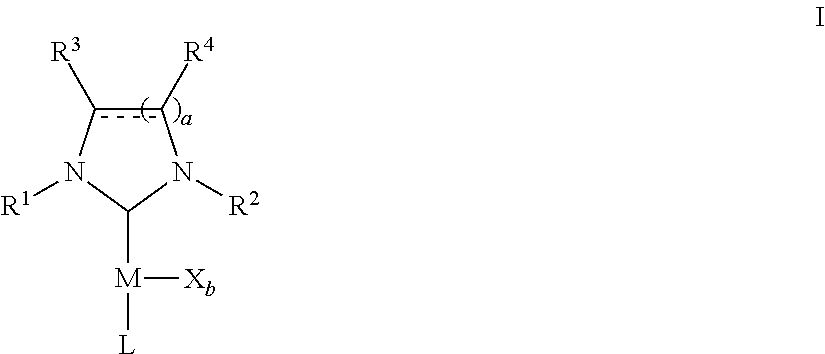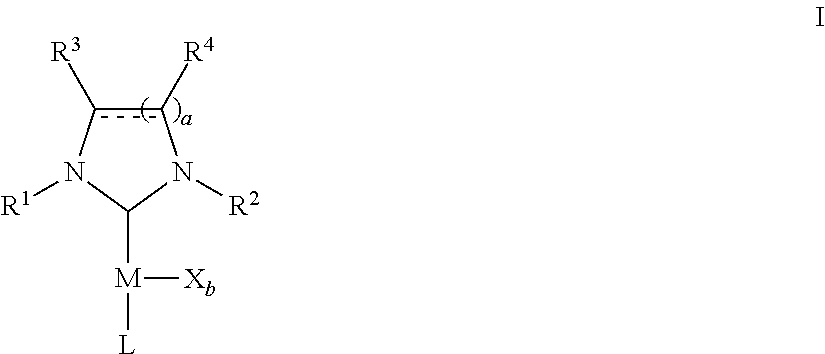Microwave-assisted synthesis of n-heterocyclic carbene transition metal complexes
- Summary
- Abstract
- Description
- Claims
- Application Information
AI Technical Summary
Benefits of technology
Problems solved by technology
Method used
Image
Examples
example 1
(NHC)Pd(acac)Cl Complexes
[0235]A microwave-vial was loaded with NHC.HCl (0.55 mmol), palladium(II) acetylacetonate (153 mg, 0.500 mmol), anhydrous THF (5 mL) and a magnetic bar. The mixture was heated in the microwave reactor for 30 min at 110° C. The solvent was removed in vacuo and the resulting product was dissolved in methylene chloride. This solution was filtered over a plug of silica gel and the silica gel was rinsed with methylene chloride. Removal of the solvent in vacuo afforded the desired products as yellow solids.
[0236](SIPr)Pd(acac)Cl:
where Ar is:
[0237]265 mg (84%) of the title compound were obtained using SIPr.HCl (235 mg, 0.550 mmol). 1H NMR (300 MHz, CDCl3): δ (ppm)=7.40 (t, 3J=7.7 Hz, 2H), 7.28 (broad d, 3J=8.0 Hz, 4H), 5.04 (s, 1H), 4.05 (s, 4H), 3.42 (broad s, 4H), 1.78 (s, 3H), 1.76 (s, 3H), 1.42 (broad s, 12H), 1.25 (d, 3J=6.8 Hz, 12H).
[0238](IPr)Pd(acac)Cl:
where Ar is:
[0239]283 mg (90%) of the title compound were obtained using IPr.HCl (234 mg, 0.550 mmol). 1H ...
example 2
(NHC)PdCl2(3-chloropyridine) Complexes
[0243]A microwave-vial was loaded with NHC.HCl (0.55 mmol), palladium(II) chloride (89 mg, 0.50 mmol), potassium carbonate (345 mg, 2.5 mmol), 3-chloropyridine (2 mL) and a magnetic bar. The mixture was heated in a microwave reactor for 45 min at 200° C. The mixture was diluted with methylene chloride, filtered over a plug of silica gel that was covered with celite and the silica gel was rinsed with methylene chloride. The solvent and excess chloropyridine were removed in vacuo, the product was triturated in pentane and the pentane was decanted. Drying in vacuo afforded the desired products as yellow solids.
[0244](IPr)PdCl2(3-chloropyridine):
where Ar is:
[0245]309 mg (88%) of the title compound were obtained using IPr.HCl (234 mg, 0.550 mmol). 1H NMR (300 MHz, CDCl3): δ (ppm)=8.60 (d, 3J=2.4 Hz, 1H), 8.52 (dd, 3J=5.5 Hz, 3J=1.3 Hz, 1H), 7.55 (ddd, 3J=8.2 Hz, 3J=2.3 Hz, 3J=1.3 Hz, 1H), 7.50 (t, 3J=7.8 Hz, 2H), 7.35 (d, 3J=7.7 Hz, 4H), 7.14 (s, 2H)...
PUM
 Login to View More
Login to View More Abstract
Description
Claims
Application Information
 Login to View More
Login to View More - R&D
- Intellectual Property
- Life Sciences
- Materials
- Tech Scout
- Unparalleled Data Quality
- Higher Quality Content
- 60% Fewer Hallucinations
Browse by: Latest US Patents, China's latest patents, Technical Efficacy Thesaurus, Application Domain, Technology Topic, Popular Technical Reports.
© 2025 PatSnap. All rights reserved.Legal|Privacy policy|Modern Slavery Act Transparency Statement|Sitemap|About US| Contact US: help@patsnap.com



